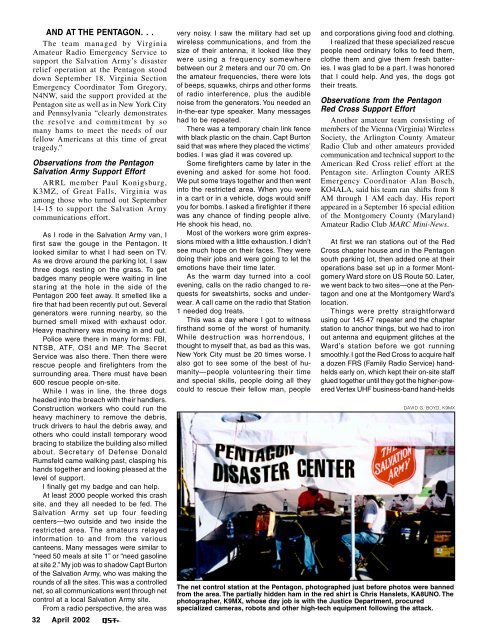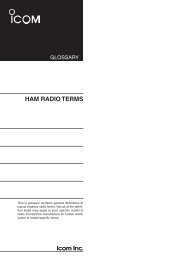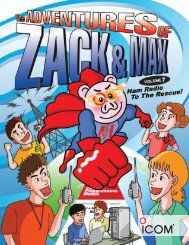SEPT 11 - New York City Amateur Radio Emergency ...
SEPT 11 - New York City Amateur Radio Emergency ...
SEPT 11 - New York City Amateur Radio Emergency ...
You also want an ePaper? Increase the reach of your titles
YUMPU automatically turns print PDFs into web optimized ePapers that Google loves.
AND AT THE PENTAGON. . .<br />
The team managed by Virginia<br />
<strong>Amateur</strong> <strong>Radio</strong> <strong>Emergency</strong> Service to<br />
support the Salvation Army’s disaster<br />
relief operation at the Pentagon stood<br />
down September 18. Virginia Section<br />
<strong>Emergency</strong> Coordinator Tom Gregory,<br />
N4NW, said the support provided at the<br />
Pentagon site as well as in <strong>New</strong> <strong>York</strong> <strong>City</strong><br />
and Pennsylvania “clearly demonstrates<br />
the resolve and commitment by so<br />
many hams to meet the needs of our<br />
fellow Americans at this time of great<br />
tragedy.”<br />
Observations from the Pentagon<br />
Salvation Army Support Effort<br />
ARRL member Paul Konigsburg,<br />
K3MZ, of Great Falls, Virginia was<br />
among those who turned out September<br />
14-15 to support the Salvation Army<br />
communications effort.<br />
As I rode in the Salvation Army van, I<br />
first saw the gouge in the Pentagon. It<br />
looked similar to what I had seen on TV.<br />
As we drove around the parking lot, I saw<br />
three dogs resting on the grass. To get<br />
badges many people were waiting in line<br />
staring at the hole in the side of the<br />
Pentagon 200 feet away. It smelled like a<br />
fire that had been recently put out. Several<br />
generators were running nearby, so the<br />
burned smell mixed with exhaust odor.<br />
Heavy machinery was moving in and out.<br />
Police were there in many forms: FBI,<br />
NTSB, ATF, OSI and MP. The Secret<br />
Service was also there. Then there were<br />
rescue people and firefighters from the<br />
surrounding area. There must have been<br />
600 rescue people on-site.<br />
While I was in line, the three dogs<br />
headed into the breach with their handlers.<br />
Construction workers who could run the<br />
heavy machinery to remove the debris,<br />
truck drivers to haul the debris away, and<br />
others who could install temporary wood<br />
bracing to stabilize the building also milled<br />
about. Secretary of Defense Donald<br />
Rumsfeld came walking past, clasping his<br />
hands together and looking pleased at the<br />
level of support.<br />
I finally get my badge and can help.<br />
At least 2000 people worked this crash<br />
site, and they all needed to be fed. The<br />
Salvation Army set up four feeding<br />
centers—two outside and two inside the<br />
restricted area. The amateurs relayed<br />
information to and from the various<br />
canteens. Many messages were similar to<br />
“need 50 meals at site 1” or “need gasoline<br />
at site 2.” My job was to shadow Capt Burton<br />
of the Salvation Army, who was making the<br />
rounds of all the sites. This was a controlled<br />
net, so all communications went through net<br />
control at a local Salvation Army site.<br />
From a radio perspective, the area was<br />
32 April 2002<br />
very noisy. I saw the military had set up<br />
wireless communications, and from the<br />
size of their antenna, it looked like they<br />
were using a frequency somewhere<br />
between our 2 meters and our 70 cm. On<br />
the amateur frequencies, there were lots<br />
of beeps, squawks, chirps and other forms<br />
of radio interference, plus the audible<br />
noise from the generators. You needed an<br />
in-the-ear type speaker. Many messages<br />
had to be repeated.<br />
There was a temporary chain link fence<br />
with black plastic on the chain. Capt Burton<br />
said that was where they placed the victims’<br />
bodies. I was glad it was covered up.<br />
Some firefighters came by later in the<br />
evening and asked for some hot food.<br />
We put some trays together and then went<br />
into the restricted area. When you were<br />
in a cart or in a vehicle, dogs would sniff<br />
you for bombs. I asked a firefighter if there<br />
was any chance of finding people alive.<br />
He shook his head, no.<br />
Most of the workers wore grim expressions<br />
mixed with a little exhaustion. I didn’t<br />
see much hope on their faces. They were<br />
doing their jobs and were going to let the<br />
emotions have their time later.<br />
As the warm day turned into a cool<br />
evening, calls on the radio changed to requests<br />
for sweatshirts, socks and underwear.<br />
A call came on the radio that Station<br />
1 needed dog treats.<br />
This was a day where I got to witness<br />
firsthand some of the worst of humanity.<br />
While destruction was horrendous, I<br />
thought to myself that, as bad as this was,<br />
<strong>New</strong> <strong>York</strong> <strong>City</strong> must be 20 times worse. I<br />
also got to see some of the best of humanity—people<br />
volunteering their time<br />
and special skills, people doing all they<br />
could to rescue their fellow man, people<br />
and corporations giving food and clothing.<br />
I realized that these specialized rescue<br />
people need ordinary folks to feed them,<br />
clothe them and give them fresh batteries.<br />
I was glad to be a part. I was honored<br />
that I could help. And yes, the dogs got<br />
their treats.<br />
Observations from the Pentagon<br />
Red Cross Support Effort<br />
Another amateur team consisting of<br />
members of the Vienna (Virginia) Wireless<br />
Society, the Arlington County <strong>Amateur</strong><br />
<strong>Radio</strong> Club and other amateurs provided<br />
communication and technical support to the<br />
American Red Cross relief effort at the<br />
Pentagon site. Arlington County ARES<br />
<strong>Emergency</strong> Coordinator Alan Bosch,<br />
KO4ALA, said his team ran shifts from 8<br />
AM through 1 AM each day. His report<br />
appeared in a September 16 special edition<br />
of the Montgomery County (Maryland)<br />
<strong>Amateur</strong> <strong>Radio</strong> Club MARC Mini-<strong>New</strong>s.<br />
At first we ran stations out of the Red<br />
Cross chapter house and in the Pentagon<br />
south parking lot, then added one at their<br />
operations base set up in a former Montgomery<br />
Ward store on US Route 50. Later,<br />
we went back to two sites—one at the Pentagon<br />
and one at the Montgomery Ward’s<br />
location.<br />
Things were pretty straightforward<br />
using our 145.47 repeater and the chapter<br />
station to anchor things, but we had to iron<br />
out antenna and equipment glitches at the<br />
Ward’s station before we got running<br />
smoothly. I got the Red Cross to acquire half<br />
a dozen FRS (Family <strong>Radio</strong> Service) handhelds<br />
early on, which kept their on-site staff<br />
glued together until they got the higher-powered<br />
Vertex UHF business-band hand-helds<br />
DAVID G. BOYD, K9MX<br />
The net control station at the Pentagon, photographed just before photos were banned<br />
from the area. The partially hidden ham in the red shirt is Chris Hanslets, KA8UNO. The<br />
photographer, K9MX, whose day job is with the Justice Department, procured<br />
specialized cameras, robots and other high-tech equipment following the attack.







